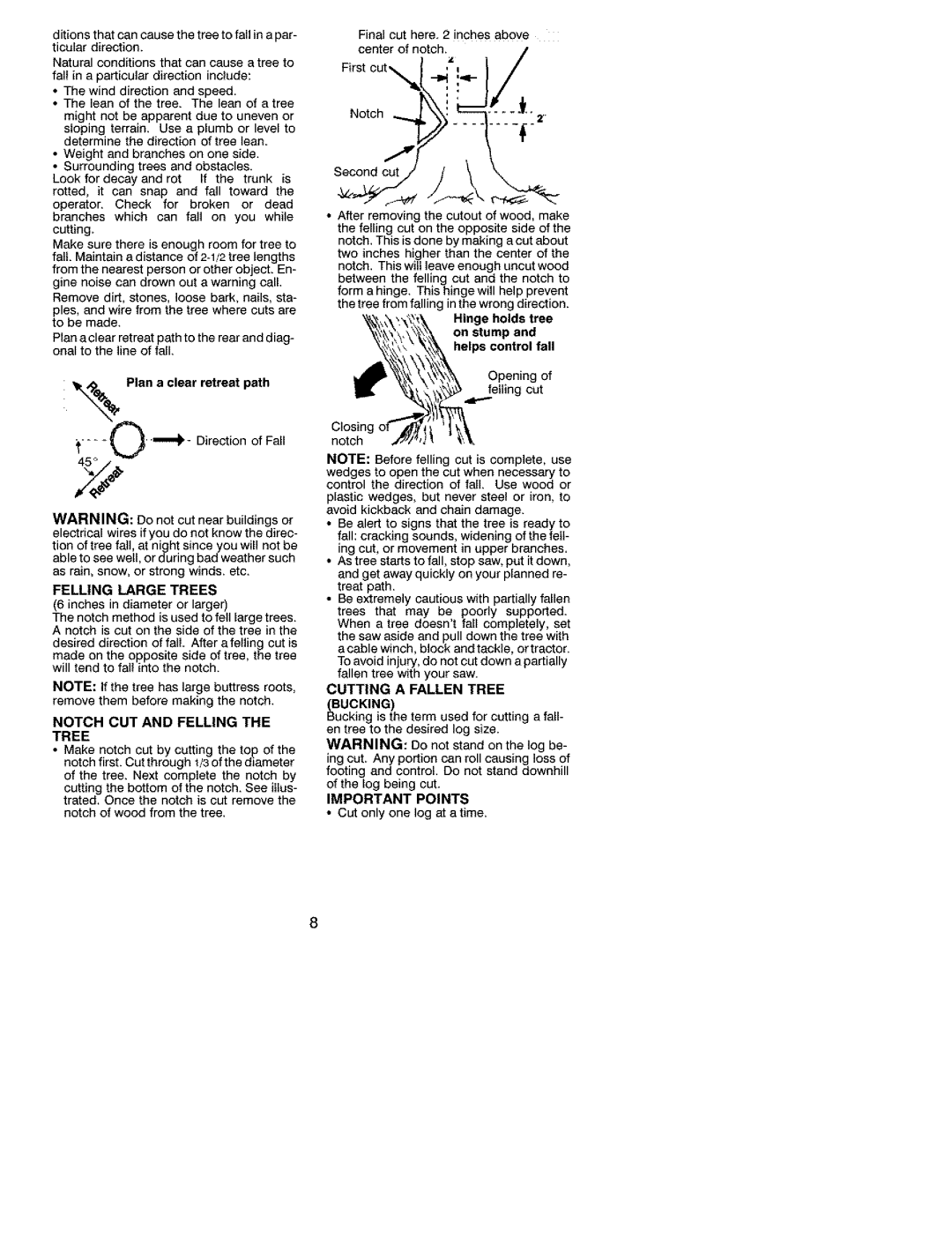
ditionsthatcancausethetreetofallinapar- ticulardirection. Naturalconditionsthatcancausetreeto fallinaparticulardirectioninclude:
•Thewinddirectionandspeed.
•Theleanofthetree.Theleanofatree mightnotbeapparentduetounevenor slopingterrainUseaplumborlevelto. determinethedirectionoftreelean.
Weightandbranchesononeside. _Surroundingtreesandobstacles. Lookfordecayandrot If thetrunkis rotted,it cansnapandfalltowardthe operatorCheckfor. brokenor dead brancheswhichcanfallon youwhile cutting. Makesurethereisenoughroomfortreeto
_,_. Plan a clear retreat path
_'.... t) ''_ - Direction of Fall
WARNING: Do not cut near buildings or
electrical wires if you do not know the direc- tion of tree fall, at night since you will not be
able to see well, or during bad weather such as rain, snow, or strong winds, etc.
FELLING LARGE TREES
(6 inches in diameter or larger)
The notch method is used to fell large trees. A notch is cut on the side of the tree in the
desired direction of fall. After a felling cut is
made on the opposite side of tree, the tree will tend to fall into the notch.
NOTE: If the tree has large buttress roots, remove them before making the notch.
NOTCH CUT AND FELLING THE TREE
•Make notch cut by cutting the top of the notch first. Cut through t/3 of the diameter
of the tree. Next complete the notch by
cutting the bottom of the notch. See illus- trated. Once the notch is cut remove the notch of wood from the tree.
8
Final cut here. 2 inches above center of notch.
Notch _ _ "___'_'__2"
•After ramovin the cutout of wood, make the felling cut on the opposite side of the notch. This is done by making a cut about two inches higher than the center of the notch. This will leave enough uncut wood
between the felling cut and the notch to form a hinge. This hinge will help prevent
the tree from falling in the wrong direction.
Hinge holds tree on stump and helps control fall
Opening of felling cut
Closin notch
NOTE: Before felling cut is complete, use
wedges to open the cut when necessary to control the direction of fall. Use wood or
plastic wedges, but never steel or iron, to avoid kickback and chain damage.
•Be alert to signs that the tree is ready to fall: cracking sounds, widening of the fell- ingcut, or movement in upper branches.
•As tree starts to fall, stop saw, put it down, and get away quickly on your planned re- treat path.
•Be extremely cautious with partially fallen trees that may be poorly supported. When a tree doesn't fall completely, set
the saw aside and pull down the tree with a cable winch, block and tackle, or tractor.
To avoid in ury, do not cut down a partially fallen tree w th your saw.
CUTTING A FALLEN TREE
(BUCKING)
Bucking is the term used for cutting a fall- en tree to the desired log size. WARNING: Do not stand on the log be- ing cut. Any portion can roll causing loss of footing and control. Do not stand downhill of the log being cut.
IMPORTANT POINTS
• Cut only one log at a time.
